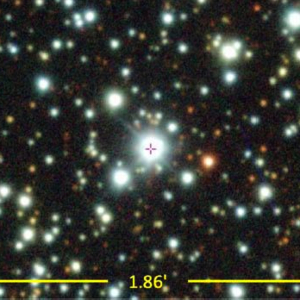TESS hunts not only exoplanets, but also special objects in the surrounding space. Among its strangest catches is object TIC 400799224, probably a binary star, in which a lot of dust spews a lot of dust at the star, with which no one can cope. The dust obscures the star with great regularity, once every 19.77 days, but each of these events is completely different. What is this?
–
In the center of the image is TIC object 400799224. Credit: Powell et al.
–
The Transiting Exoplanet Survey Satellite, or TESS, launched into space in 2018 to discover exoplanets, especially the smaller ones at nearby stars. Today, it has 172 confirmed exoplanets and a list of 4,703 exoplanet candidates. Its sensitive optics capture a large part of the sky, which is about twice the size of the constellation Orion.
TESS has also compiled the so-called TESS Input Catalog (TIC), which includes over 1 billion objects. Among them are special matters, including pulsating stars, shock waves, decaying planets, gravitational binary stars, eclipsing triplets, disk eclipses, and other remarkable objects. Among them is also the object TIC 400799224, which is really strange.

Logo. Kredit: NASA/Goddard Space Flight Center.
–
This mysterious object was discovered by a large team of astronomers who rummaged through the TIC catalog using clever artificial intelligence. They trained her to observe hundreds of thousands of known variable objects. The same method has previously revealed, for example, the disintegrating planets and objects from which dust flows. The exceptional TIC 400799224 was noticed by accident when it suddenly brutally faded, about 25 percent in a matter of hours. This decline was followed by several dramatic changes in clarity. You don’t just see something like that.

TESS exoplanet hunter. Credit: NASA.
–
Astronomers have studied object TIC 400799224 with various instruments. As is usual in similar cases, they also searched images from the period preceding the observation of the TESS telescope. They came to the conclusion that the object in question was probably a binary star system, one star of which pulsates with a period of 19.77 days. These pulses appear to be generated by this star’s partner, which periodically ejects clouds of dust covering the star. These events occur very regularly, but the overlaps themselves surprisingly differ significantly from each other, in their shape and duration. We detect only about a third of these events from Earth, the rest is too vague.
Astronomers are wondering what the body is. It’s a real mystery. It expels a huge amount of dust. If, for example, it were a decaying body the size of the dwarf planet Ceres (equatorial diameter 975 km) from the solar system, it would only take a few thousand years to completely dissipate. It is therefore most remarkable that during the 6 years of observation, the mysterious object TIC 400799224 maintains exactly the same periodicity and the body expelling the dust remains clearly intact.
Of course, researchers intend to observe the TIC 400799224 object in the future as well. They will also focus on historical observations, with the help of which they want to determine the behavior of the object over a number of decades.
Literature
Harvard-Smithsonian Center for Astrophysics 31. 12. 2021.
Astronomical Journal 162: 299.
– .


